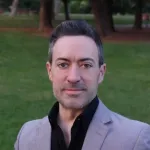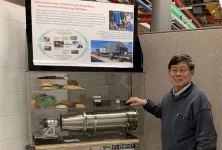(Press-News.org) LA JOLLA (August 14, 2024)—Professor Rusty Gage has been awarded the 2024 J. Allyn Taylor International Prize in Medicine by the Schulich School of Medicine & Dentistry and the Robarts Research Institute at Western University. One of the most prestigious medical research awards in Canada, the Taylor Prize recognizes scientists for transformative, career-defining work in basic sciences, translational research, and medical innovations.
This year’s prize specifically honors a research leader in aging-related medical science and research—a long-term focus of Gage and his lab. Gage will receive $50,000 and be celebrated at a Robarts Research Institute event in November.
“Rusty’s groundbreaking efforts to develop sophisticated models of the aging brain continue to enrich our understanding of human health and disease,” says Salk President Gerald Joyce. “This prize is a testament to his ingenuity and leadership in the field of neuroscience.”
Gage is a professor in the Laboratory of Genetics, Vi and John Adler Chair for Research on Age-Related Neurodegenerative Disease, and former president of the Salk Institute.
Gage studies how genes and environmental factors guide the plasticity, adaptability, and diversity of the human brain. To do this, he develops laboratory models of the human brain by reprogramming patients’ skin cells into induced pluripotent stem cells, induced neurons, and organoids (3D collections of cells that mimic human tissues). These cutting-edge models have expanded what’s possible in neuroscience research and allowed Gage to make many exciting discoveries about the brain and age-related diseases like Alzheimer’s and Parkinson’s.
In 2015, Gage’s lab pioneered a method to convert older people’s skin cells into brain cells, all while retaining the cells’ molecular signatures of aging. In 2022, the lab used this method to discover that deteriorating neurons can be a source of brain inflammation in Alzheimer’s disease. In two subsequent studies, Gage’s lab introduced non-neuronal cells called microglia and astrocytes to their brain organoids—a huge step for making organoid models more accurate representations of the human brain.
As a scientific leader, Gage models the importance of collaboration through his work with Salk colleagues and global collaborators. Alongside Professor Jan Karlseder, Gage helped create another type of tool to help scientists study aging called Telo-seq. The tool was designed to revolutionize the study of telomeres—the protective endcaps of our chromosomes that shrink as we age. In a new collaboration with Assistant Professor Pallav Kosuri funded by the W. M. Keck Foundation, he plans to investigate the way brain and heart cell functions decline over time due to ribosubstitution events, in which damaged DNA is repaired with pieces of RNA. Gage is also set to lead a new California Institute for Regenerative Medicine (CIRM) funded Shared Resources Laboratory focused on stem cell-based models of aging and neurodegeneration.
Gage has earned numerous awards and accolades in his career, including an International Society for Stem Cell Research Achievement Award in 2020 and ARCS Foundation Scientist of the Year in 2018. He has also remained on Clarivate’s Highly Cited Researchers list for nine years running. Additionally, he is a member of the US National Academy of Medicine, US National Academy of Sciences, American Academy of Arts and Sciences, and American Philosophical Society.
About the Schulich School of Medicine & Dentistry:
Western University’s Schulich School of Medicine & Dentistry is one of Canada’s preeminent medical and dental schools. Established in 1881, it was one of the founding schools of Western University. For more than 130 years, the School has demonstrated a commitment to academic excellence and a passion for scientific discovery.
About the Robarts Research Institute:
Opened in 1986, Robarts Research Institute at Western University is a medical research facility in London, Ontario, with more than 600 people working to investigate some of the most debilitating diseases of our time, from heart disease and stroke to diabetes, Alzheimer’s, and many forms of cancer.
About the Salk Institute for Biological Studies:
Unlocking the secrets of life itself is the driving force behind the Salk Institute. Our team of world-class, award-winning scientists pushes the boundaries of knowledge in areas such as neuroscience, cancer research, aging, immunobiology, plant biology, computational biology, and more. Founded by Jonas Salk, developer of the first safe and effective polio vaccine, the Institute is an independent, nonprofit research organization and architectural landmark: small by choice, intimate by nature, and fearless in the face of any challenge. Learn more at www.salk.edu.
END
Salk Professor Rusty Gage awarded 2024 Taylor International Prize in Medicine
2024-08-20
ELSE PRESS RELEASES FROM THIS DATE:
Heart data unlocks sleep secrets
2024-08-20
We know that quality sleep is as essential to survival as food and water. Yet, despite spending a third of our lives in slumber, it largely remains a scientific mystery.
Not that experts haven’t tried.
Sleep analysis, also known as polysomnography, is used to diagnose sleep disorders by recording multiple types of data, including brain (electroencephalogram or EEG) and heart (electrocardiogram or ECG). Typically, patients are hooked up to dozens of sensors and wires in a clinic, tracking brain, ...
Development of a model capable of predicting the cycle lives of high-energy-density lithium-metal batteries
2024-08-20
1. NIMS and SoftBank Corp. have jointly developed a model capable of predicting the cycle lives of high-energy-density lithium-metal batteries by applying machine learning methods to battery performance data. The model proved able to accurately estimate batteries’ longevity by analyzing their charge, discharge and voltage relaxation process data without relying on any assumption about specific battery degradation mechanisms. The technique is expected to be useful in improving the safety and reliability of devices powered by lithium-metal batteries.
2. Lithium-metal ...
UVA Engineering Professor’s $600,000 grant set to innovate pediatric brain tumor treatment
2024-08-19
Natasha Sheybani, assistant professor of biomedical engineering at the University of Virginia School of Engineering, will collaborate with researchers at Children’s National Hospital to study the combination of two therapies for pediatric brain cancer.
High-risk brain tumors in children often don’t respond well to existing chemotherapy and radiation treatments, but Sheybani and her collaborators hope their fusion of therapies will offer a better option.
Over the two-year project, researchers ...
Illinois researchers develop index to quantify circular bioeconomy
2024-08-19
URBANA, Ill. – As the world faces the challenges of mitigating climate change and providing resources for a growing population, there is increasing focus on developing circular economies for sustainable production. But to evaluate strategies and impacts, it is necessary to have reliable metrics. Researchers at the University of Illinois Urbana-Champaign have developed a Circularity Index that provides a comprehensive method to quantify circularity in bioeconomic systems. In a new paper, they outline the method and apply it to two case studies – a corn/soybean farming operation and the entire U.S. food and agriculture system.
“The ...
Less severe forest fires can reduce intensity of future blazes
2024-08-19
Not all forest fires have devastating effects. Low- and moderate-severity forest wildfires can reduce the intensity of future conflagrations for as long as 20 years in certain climates, according to new research by the University of California, Davis.
The extent of reduced severity of these second fires, or reburns, and the duration of the moderating effect, varies by climate, forest type and other factors. But initial fires continue to mitigate future severity even during extreme weather, such as wind, high temperatures and drought, research published in the journal Ecological ...
Electric reactor could cut industrial emissions
2024-08-19
Currently, industrial processes in the U.S. account for approximately a third of the country’s carbon dioxide emissions – even more than the annual emissions from passenger vehicles, trucks, and airplanes combined. Decarbonizing this sector is a challenging but vital step in mitigating impacts on our future climate.
Researchers at Stanford Engineering have designed and demonstrated a new type of thermochemical reactor that is capable of generating the immense amounts of heat required for many industrial processes using electricity instead of burning fossil fuels. The design, published Aug. ...
Causal relationship between PECAM-1 level and cardiovascular diseases
2024-08-19
https://www.scienceopen.com/hosted-document?doi=10.15212/CVIA.2024.0032
Announcing a new article publication for Cardiovascular Innovations and Applications journal. Platelet endothelial cell adhesion molecule (PECAM-1) is present in the vascular endothelium and plays important roles in various biological processes. Several recent studies have reported associations between PECAM-1 and certain subtypes of cardiovascular diseases (CVDs). However, further research is necessary to clarify the causal effects of PECAM-1 on CVDs.
To determine whether PECAM-1 and CVDs are causally ...
The plausible role of vascular adhesion molecules in cardiovascular diseases
2024-08-19
https://www.scienceopen.com/hosted-document?doi=10.15212/CVIA.2024.0046
Announcing a new article publication for Cardiovascular Innovations and Applications journal. Vascular Adhesion Molecules (VAMs) appear to play important roles in the development of Cardiovascular Diseases (CVD). The roles of these molecules in mediating inflammation, endothelial dysfunction, and plaque formation suggest that they may be important as both biomarkers and therapeutic targets. Understanding and targeting these molecules are hoped to substantially contribute to ...
Whole-exome sequencing identifies three novel TTN variants in Chinese families with dilated cardiomyopathy
2024-08-19
https://www.scienceopen.com/hosted-document?doi=10.15212/CVIA.2024.0040
Announcing a new article publication for Cardiovascular Innovations and Applications journal. Dilated cardiomyopathy (DCM), a severe heart disease, is the leading cause of heart failure and sudden cardiac death worldwide. DCM is defined by a dilated and deficient systolic left ventricle (LV) and is a major risk factor for morbidity and mortality worldwide. DCM progression can be ascribed to genetic and non-genetic factors, including hypertension, infectious agents, toxins, and drugs.
Sarcomere genes play crucial roles in myocardial cells’ physical structure and physiological function. Various cardiomyopathies ...
Key biofuel-producing microalga believed to be a single species is actually three
2024-08-19
MEDIA INQUIRES
WRITTEN BY
Laura Muntean
Ashley Vargo
laura.muntean@ag.tamu.edu
601-248-1891
FOR ...






